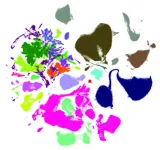Revealing a key mechanism of rapid centromere evolution
Researchers clarify a key mechanism of genetic element insertions in the centromere, the “waist” of a chromosome
2025-01-01
(Press-News.org)
A joint research group team led by Sayuri Tsukahara and Tetsuji Kakutani of the University of Tokyo has clarified a mechanism of how retrotransposons, genetic elements that can “jump around” chromosomes and are known drivers of evolution, preferentially insert in the centromere. The findings were published in the journal Nature.
The centromere is the thinnest part of the chromosome that divides it into a long and short arm, much like how the waist separates the upper and lower body. Its role in transmitting information via cell division has been preserved across eukaryotes, cells with membrane-bound nuclei. This is despite the substantial inter- and intraspecies variations in its DNA sequence, a phenomenon called the “centromere paradox.” Researchers have known that retrotransposon insertion in the centromere has contributed to this variation and rapid evolution. However, the mechanisms of insertion have not been known. To fill the gap, the researchers investigated the insertion mechanisms of retrotransposons Tal1 and EVD in the plant Arabidopsis lyrata, commonly known as lyrate rockcress.
“We have long known that a large portion of the eukaryotic genome consists of transposons concentrated around the centromere,” says Tsukahara, the first author. “However, what biases their distribution and what their role is in the centromere had not been known. Investigating the mechanisms of retrotransposon integration may reveal how evolution “constructed” eukaryotic genomes.”
Until recently, reference centromere data for Arabidopsis and many other organisms did not exist. However, thanks to recent advances in DNA sequencing, such reference data could finally be collected, making this study possible. The researchers also employed a method previously developed by some of the co-authors of this paper, created to detect retrotransposon insertions with great efficiency (TEd-seq). Combining these two technical improvements, the researchers could “read” the insertion sites and map the results onto the centromere region of the reference data more accurately.
“We were surprised at the TEd-seq results,” Tsukahara remembers, “because retrotransposon Tal1 and EVD showed strong integration biases. Tal1 integrated into the centromere, with almost no insertions in the chromosomal arm region. On the other hand, EVD integrated into the chromosomal arm, although EVD is closely related to retrotransposon Tal1.”
As an additional discovery, the researcher found these insertion biases reversed when they swapped a certain region (c-terminal integrase region) of the two retrotransposons. With this sign that nature has many more tricks up its sleeve we do not yet appreciate, Tsukahara describes potential next steps for research.
“We were amazed by the sophisticated integration mechanisms of retrotransposons. We would love to explore in more detail the mechanisms of centromere-specific integration of retrotransposon Tal1. For example, we would like to identify the factors that bind to Tal1 and investigate whether there is a bias in transmission to Tal1-contained centromere to offspring. It may lead to revealing the impact of retrotransposon insertions into centromere.”
END
[Attachments] See images for this press release:


ELSE PRESS RELEASES FROM THIS DATE:
2025-01-01
New York, NY—January 1, 2025—Mechanical force is an essential feature for many physical and biological processes. Remote measurement of mechanical signals with high sensitivity and spatial resolution is needed for a wide range of applications, from robotics to cellular biophysics and medicine and even to space travel. Nanoscale luminescent force sensors excel at measuring piconewton forces, while larger sensors have proven powerful in probing micronewton forces. However, large gaps remain in the force magnitudes that can be probed remotely from subsurface ...
2025-01-01
Francis Crick Institute press release
Under strict embargo: 16:00 GMT Wednesday 1 January 2025
Peer reviewed
Observational study
Ancient people
Ancient DNA unlocks new understanding of migrations in the first millennium AD
Waves of human migration across Europe during the first millennium AD have been revealed using a more precise method of analysing ancestry with ancient DNA, in research led by the Francis Crick Institute.
Researchers can bring together a picture of how people moved across the world by looking at changes in their DNA, but this becomes a lot harder when historical ...
2025-01-01
Fast radio bursts are brief and brilliant explosions of radio waves emitted by extremely compact objects such as neutron stars and possibly black holes. These fleeting fireworks last for just a thousandth of a second and can carry an enormous amount of energy — enough to briefly outshine entire galaxies.
Since the first fast radio burst (FRB) was discovered in 2007, astronomers have detected thousands of FRBs, whose locations range from within our own galaxy to as far as 8 billion light-years away. Exactly how ...
2025-01-01
Leuven, 2 January 2024 – Researchers from the lab of Prof. Sarah-Maria Fendt (VIB-KU Leuven) and colleagues have uncovered that the availability of the amino acid aspartate is one reason why the lung is a frequent organ of metastasis. Their work appears in Nature and improves our understanding of cancer biology while providing the foundation for new therapeutic interventions in metastatic diseases.
A role for aspartate
More than half of cancer patients in whom the cancer spreads beyond the primary site have lung metastases. What makes the lungs such a ...
2025-01-01
EMBARGOED FOR RELEASE: Jan. 1, 2025, 11 a.m. ET
CONTACT:
NIAPressTeam@mail.nih.gov, 301-496-1752
Aging may change some brain cells more than others
NIH-funded mouse study provides roadmap for how aging may alter brain cell genetic activity
Based on new brain mapping research funded by the National Institutes of Health (NIH), scientists have discovered that not all cell types in the brain age in the same way. They found that some cells, such as a small group of hormone-controlling cells, may undergo more age-related changes in genetic activity than others. The results, published ...
2025-01-01
WASHINGTON, D.C., Jan. 1, 2025—As the body of research grows around the potential promise of psychedelic medications in psychiatry, many questions and challenges remain. The January issue of the American Journal of Psychiatry features a series of articles, including new research, reviews and commentaries, on the use of these treatments.
The issue addresses many of the ongoing challenges and looming questions in the field of psychiatric psychedelic research and treatment. These include issues relevant to basic ...
2024-12-31
TORONTO, Ontario, Canada, 31 December 2024 - In a comprehensive Genomic Press Interview, leading geneticist Dr. Cathy Barr unveils crucial discoveries about the complex interplay between genes and childhood psychiatric disorders. As a Senior Scientist at both the Hospital for Sick Children and Krembil Research Institute, Dr. Barr's research illuminates the genetic foundations of conditions including depression, attention-deficit/hyperactivity disorder, reading disabilities, and Tourette syndrome.
"After decades of searching ...
2024-12-31
AURORA, Colo. (Dec. 31, 2024) – A groundbreaking study has shed light on the complex interactions between dystrophin, a protein critical to muscle stability, and its partner protein, dystrobrevin, offering new pathways for understanding and treating Duchenne Muscular Dystrophy (DMD).
Published in the December issue of the Journal of Biological Chemistry, researchers characterize the mysterious C-terminal (CT) domain of dystrophin and its role in stabilizing cellular membranes across various tissues.
DMD, a severe genetic disorder that causes muscle weakness and shortens lifespans, arises from mutations in the gene encoding ...
2024-12-31
Scientific research explores the potential of DNNs in transforming fragrance design. By analyzing the sensing data of 180 essential oils, the DNN was trained using the odor descriptor data from 94 essential oils to generate fragrance profiles, validated through sensory evaluations to align with human olfactory perceptions. The study underscores the technological ability to streamline fragrance creation, reduce costs, and foster innovation, opening up exciting possibilities for personalized and scalable scent development.
Deep Neural Networks (DNNs) have become an essential driver of innovation across various industries, ...
2024-12-31
A recent review is transforming the landscape of craniomaxillofacial bone regeneration with the introduction of personalized bioceramic grafts. This pioneering research explores the fabrication and clinical potential of synthetic grafts created through additive manufacturing (AM), addressing key limitations of traditional autogenous grafts. By focusing on 3D-printed bioceramics tailored to meet individual patient needs, the study marks a significant advancement in both precision medicine and patient-specific care, offering new hope for those requiring bone reconstruction.
Craniofacial bone defects, resulting from trauma, congenital conditions, or surgical ...
LAST 30 PRESS RELEASES:
[Press-News.org] Revealing a key mechanism of rapid centromere evolution
Researchers clarify a key mechanism of genetic element insertions in the centromere, the “waist” of a chromosome







